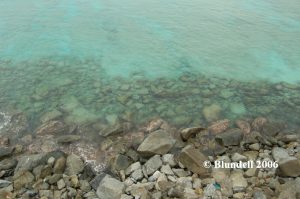You probably stopped building sand castles a few trips ago– Amie Hancey (8/24/06)

A rocky coast can be the best place to see and experience marine life. However for many people this coastline is not ideal as their interests may not include the local marine life.
This article is a follow up to what became two very popular articles. I first wrote about tide pool life (Blundell 2006a) and then specifically about the coastal areas of Western United States (Blundell 2006b). As a heavily populated area (and more importantly heavily visited area) these articles drew the interest of many readers. I received numerous emails and several readers brought up the same topics. Readers asked for information regarding coastal activities that do not include tide pooling (for lack of a better term) and human impact on tide pools. I will follow up the previous two articles by looking at these topics as Human Visitors and Their Usage as Part 3; and using Human Visitors and Their Impact as Part 4.
Visitor Usage
The activities of visitors in an intertidal zone can be divided into two areas: Active and Passive. Active activity would include handling organisms, rocks, or animals. Passive activity would include walking and sightseeing. But what about the visitors that are not in the intertidal zone? Interestingly a study by Kimura et al. found that 85% of visitors to the Point Pinos California area did not enter the intertidal zone (Kimura et al., 2003). In fact this study estimates over 280,000 people visit this area annually without entering the intertidal zone. The people are often found in the parking lots and on the rocky cliffs. So how exactly do these people use or utilize the tide areas? That itself is a very difficult question to answer. I would like to say thank you to all those readers who sent me input on their favorite coastline activities. Some of those include:

Playing with Pets- usually not an activity in the water and does not have an impact on the aquatic life.

Coastline Activities- very upon several types. Most do not use the intertidal zone and are not harmful to aquatic life. Shown here Mike Lindsay demonstrates an artistic activity.

Building Sandcastles- this activity takes place in the intertidal zone but does not harm marine life.

Bird Watching (Birding)- usually takes place out of the water and has no impact on the aquatic life.

Wading and Swimming- an intertidal activity with little impact to the aquatic life. Most of the impact due towalking on the substrate.

Fishing- an intertidal activity that does impact the local marine life. Nearly all locations require licenses and are managed to ensure impact is controlled. It should also be mentioned that the impact is not widespread but is usually targeting specific animals (like large fishes).
Conclusion
As I have shown many visitors to tide areas are not interested or at least not involved in observing the marine life. Many people use the areas for recreation with very little to no impact on the marine environment.

To Amie Hancey- thank you for helping me keep things in perspective. I haven’t stopped building sand castles and I hope I never do…
Acknowledgements
I would first like to thank the many readers who have submitted ideas and testimonials. The Southern California Marine Aquarium Society and the Marine Aquarium Society of Los Angeles County have been very helpful with this project. The two organizations have been generous enough to help sponsor my fall travels and projects. Appreciation is owed to Michael Lindsay and the Aquatic & Terrestrial Research Team. Both made contributions financially and with submitted photographs for this project.
Author Information
Adam Blundell M.S. works in Marine Ecology, and in Pathology for the University of Utah. He is also Director of The Aquatic & Terrestrial Research Team, a group which utilizes research projects to bring together hobbyists and scientists. His vision is to see this type of collaboration lead to further advancements in aquarium husbandry. While not in the lab he is the former president of one of the Nation’s largest hobbyist clubs, the Wasatch Marine Aquarium Society (www.utahreefs.com). Adam has earned a BS in Marine Biology and an MS in the Natural Resource and Health fields. Adam can be found at [email protected].
References
- Blundell, A., (2006a) “Tide Pools Part 1: An Introduction to Tide Pools”, http://www.advancedaquarist.com/2006/2/lines, USA.
- Blundell, A., (2006b) “Tide Pools Part2: A Review of the United States’ Pacific Coast”, http://www.advancedaquarist.com/2006/3/lines, USA.
- GMA, (1998) “Tidepool: Window into the Sea”, Gulf of Maine Aquarium, website publication, http://octopus.gma.org/katahdin/tidepool.html, USA.
- Kimura, S., et al (2003) “Monterey Bay National Marine Sanctuary: A Comparative Intertidal Study and User Survey, Point Pinos, California”, Tenera Environmental, San Luis Obispa, California, USA.
- Morabito. P., et al (2003) “Completing the California Coastal Trail”. Coastal Conservancy, California USA.
- OCVA (2006) “ Recreation on the Coast” Oregon Coast Visitors Association, web posting http://www.visittheoregoncoast.com/home.cfm?dir_cat=15389, USA.
- San Diego North Press Room (2006) “San Diego North Convention & Visitors Bureau Generated $33.8 Million in Visitor Spending to San Diego North in 2004”, web posting http://www.sandiegonorth.com/pressroom/pr-20.asp, USA.










0 Comments